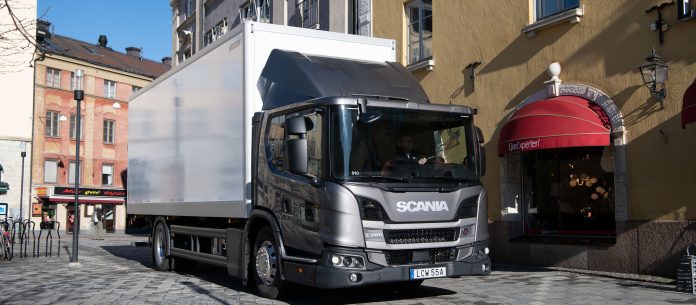Scania is introducing EAS as an option on its trucks. The electrically assisted steering will enhance the driving experience and enable new or improved driver support systems. Together they will help reduce the mental load on drivers from handling huge vehicles such as truck combinations on busy high-ways. The EAS-based ADAS functions are active at speeds above 60 km/h, although drivers must still keep their hands on the steering wheel.
“The electrically assisted steering is a great addition to our offer, enabling significant capabilities in the name of increased comfort and road safety,” says Stefan Dorski, Senior Vice President and Head of Scania Trucks. “Reducing some of the mental load that comes with being responsible for huge vehicles is a great support to all the truck drivers out there serving the rest of us.”
Scania’s EAS system is electro-hydraulic, speed dependent and offers functionality such as active return and compensation for side wind-induced offset. The control algorithm includes factors such as velocity, ensuring that the steering wheel torque is always proportional to the resistance coming from the wheels. With the electro-hydraulic steering, the wheel steers back to neutral by itself. This is extra beneficial when reversing.
“EAS and the support systems should be exactly that, supportive,” says Dorski. “We have no intention to take away our renowned road-handling capabilities or the great feel of driving a Scania. And it is important to understand that the driver is still responsible and in command, despite the comfort and safety functions.”
 Scania trucks with EAS can be ordered with several smart support systems that , based on a de-facto standard in the automotive industry, all are identified using confusing acronyms. Scania’s answer is to bundle these support systems into three packages – named Detection, Prevention, and Comfort – that will guide potential customers by through a simple and logical structure.
Scania trucks with EAS can be ordered with several smart support systems that , based on a de-facto standard in the automotive industry, all are identified using confusing acronyms. Scania’s answer is to bundle these support systems into three packages – named Detection, Prevention, and Comfort – that will guide potential customers by through a simple and logical structure.
Most of the functions can be activated or deactivated by the driver. Some also have partly overlapping functionality, depending on factors such as speed, monitoring area, range and the availability of road markings in good condition.
The EAS-based systems all share a common warning logic with escalating levels of activation with sound, coloured lights or, eventually in some cases, active steering of the truck.
Comfort and/or safety
The three new functions that are made possible by the EAS introduction are the following, adding either comfort or increased safety:
LKA – Lane Keep Assist
LKA is constantly monitoring the lane markings to keep the vehicle centred in the lane by utilising active steering. LKA provides support when it is activated and the activation conditions (speed of at least 60 km/h) are fulfilled.
LDW AS – Lane Departure Warning with Active Steering
This is an extension to the standard LDW function. It not only detects potential lane departures but also intervenes by steering the vehicle back into the lane. Intended lane changes, when the driver makes use of the direction indicator lamp, are of course not affected.
LCP – Lane Change Collision Prevention
LCP works together with Scania’s Blind Spot Warning system to avoid lane change incidents. When BSW triggers its most intense warning, by detecting for example another vehicle, LCP uses active steering to stop the lane change (even if the direction indicator lamps are activated) and bring the truck back to its former lane. “EAS brings more capabilities than you might first think of,” says Dorski. “Not only does it add comfort and relief for all kinds of normal driving, but it can also help mitigate incidents. The ADAS features help by taking out some of the concrete stress factors, such as blind spots, which is highly beneficial for truck drivers.”
Source: Scania




